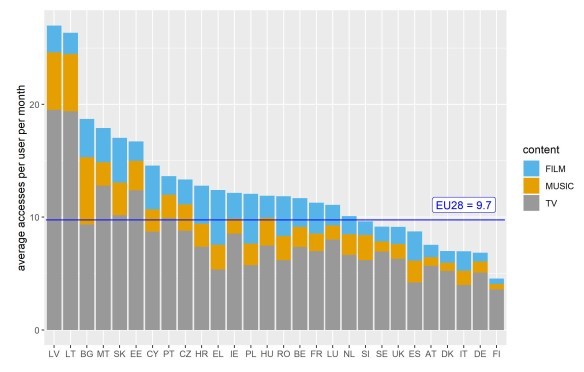
Research released by the EUIPO last week revealed that pirate IPTV services generate nearly €1 billion in revenue per year. That’s in Europe alone.
The figure confirmed that piracy remains a massive problem, but a second study also delivered some more positive news. From 2017 to 2018, access to pirated content across Europe dropped by more than 15 percent.
This headline figure was undoubtedly welcomed by copyright holders, but the broader report deserves more in-depth analysis.
For starters, the study only covers part of the piracy landscape. It is based on data provided by the piracy tracking company MUSO which solely looks at website visits. This means that apps, streaming devices, and IPTV services are not included.
This may shed a different light on the piracy drop, as these untracked piracy channels have grown explosively in recent years. According to some, these streaming tools are the largest piracy threat at the moment. As such, it’s entirely possible that overall piracy levels didn’t drop, or could even have grown.
When we asked EUIPO about this caveat, it informed us that MUSO’s data, together with that from the European Audiovisual Observatory and Eurostat, was chosen to get the most complete picture possible.
“The MUSO database was chosen as a source of data to enable us to get as full a picture as possible of online copyright infringement in the EU to which the methodology could be applied,” EUIPO informed us.
That makes sense, as the newer piracy tools are simply harder to track, so there may simply be no data available.
While EUIPO’s ‘picture’ only covers part of the piracy landscape, it is very detailed and suitable for comparisons over time, based on a wide variety of variables. This provided some interesting insights, especially when it comes to regional differences.
For example, total piracy, specified by the number of site visits per user per month, is by far the highest in Latvia and Lithuania. The relative piracy volume there is more than six times as high as in Finland, as can be seen below.

The logical conclusion would be that piracy is far more prevalent in countries on the left. However, caution is warranted, as this only covers site-based piracy.
Last week, the other EUIPO study showed that IPTV piracy is below average in Latvia, while it’s high in this report. On the other hand, site-based piracy is below-average in Spain, where IPTV piracy is thriving. And we haven’t even considered streaming boxes and apps.
One major difference between site-based piracy and IPTV piracy is that the latter usually requires a subscription. In other words, people have to pay to pirate. That may, at least in part, be due to regional differences, as countries differ in their average income per person.
The money element was also considered in the EUIPO study. Following statistical analyses, the researchers found that a lower income per capita is linked to more piracy. Again, this is solely based on website visits.
“Among the socio-economic factors, the level of income per capita and the extent of inequality seem to have the greatest impact on consumption of pirated content: high per capita income and a low degree of income inequality are associated with lower levels of illicit consumption,” the report concludes.
The link between income and piracy is not counterintuitive. That’s also true for the link that was found between social acceptance of piracy and piracy volume. What is surprising, however, is that awareness of legal services and piracy is absent for some content.
EUIPO found that more awareness of legal TV services was linked to more TV piracy. For music, a similar trend was found, albeit not statistically significant. More awareness of legal movie services, on the other hand, was linked to less piracy, as expected.
“It appears that the relationship between legal offer and piracy is a complex one and merits further investigation,” EUIPO concludes.
Overall the EUIPO study provides some interesting views on the piracy landscape in the EU. While it only covers site-based traffic, it’s clear that piracy habits differ greatly from country to country, and that they’re not always easy to grasp.
—
A copy of the report titled: “Online copyright infringement in the European Union” is available here (pdf).





